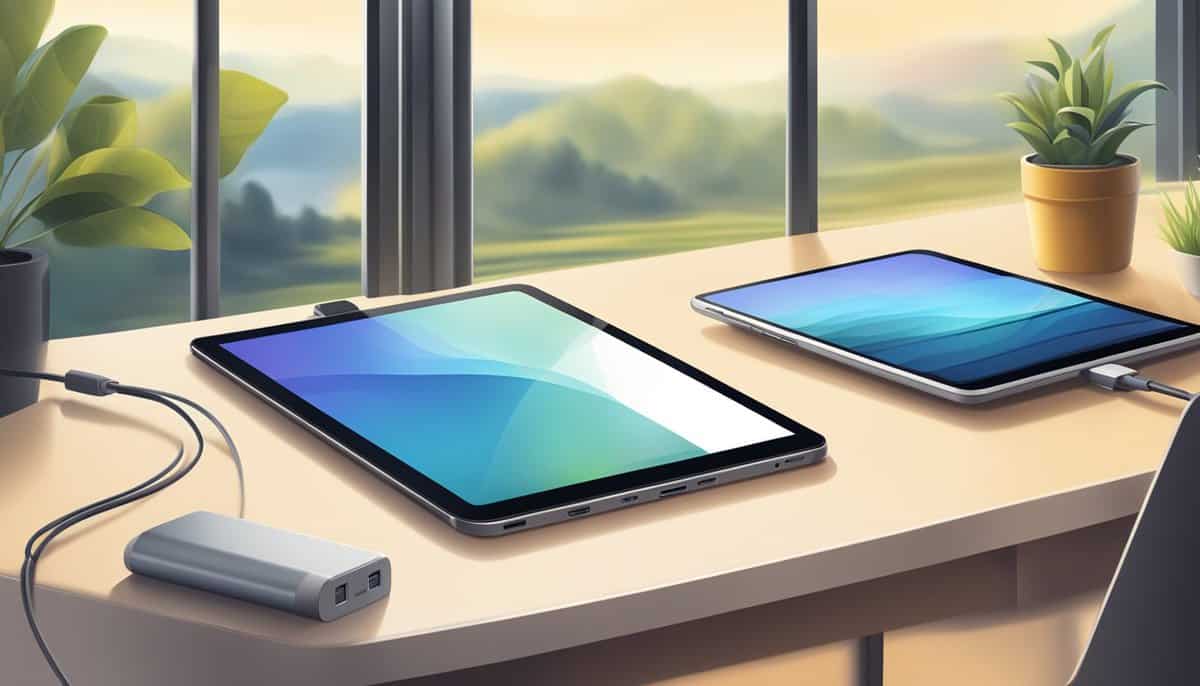Does your laptop die in the middle of a lecture? Does your smartphone run out of juice halfway through the day?
With a few smart strategies, you can maximize the battery life of your devices and keep them running longer.
The key lies in knowing which settings to adjust and what habits to adopt to prevent battery drain.
Simple changes like dimming your screen and turning off unused connectivity features can make a big difference. On your smartphone, reducing the screen brightness or enabling battery saver mode helps a lot. Your laptop and tablet also have settings that can extend battery life, so take the time to explore them.
Did you know that maintaining a cool temperature can also preserve battery health? Heat is a battery’s enemy, so avoid leaving your devices in hot places like your car on a sunny day. Frequent fast charging can also degrade the battery over time, so opt for regular charging when you can.
Key Takeaways
- Adjust screen brightness and power settings to extend battery life.
- Disable unnecessary connectivity features like Wi-Fi and Bluetooth when not in use.
- Avoid exposing your devices to high temperatures and use regular charging methods.
Understanding Battery Technology
When it comes to getting the most out of your devices, knowing how your battery works is key. This section focuses on the components of lithium-ion batteries and how temperature affects battery life and health.
Components of Lithium-Ion Batteries
Lithium-ion batteries are widely used in many devices like laptops, smartphones, and tablets. These batteries usually have several parts: anode, cathode, electrolyte, and separator.
Anode and Cathode: The anode is usually made of graphite, while the cathode is often a metal oxide. These materials allow for the movement of lithium ions between them, generating power.
Electrolyte: This liquid or gel substance helps lithium ions flow between the anode and cathode.
Separator: A physical barrier that keeps the anode and cathode from touching, preventing short circuits.
Understanding these components helps you realize why practices like avoiding full charges and deep discharges can extend your battery’s lifespan. Each charge and discharge cycle degrades the materials inside, making it crucial to handle your devices properly.
The Role of Temperature in Battery Health
Temperature significantly impacts the battery life and health of lithium-ion batteries. These batteries prefer temperatures between 20°C to 25°C (68°F to 77°F).
High Temperatures: Excessive heat can cause the battery to deteriorate faster, reducing its capacity and lifespan. For instance, leaving your phone in a hot car can severely damage the battery.
Low Temperatures: On the flip side, extreme cold can slow down the chemical reactions inside the battery, making it less efficient.
By keeping your devices in moderate temperatures, you help maintain battery longevity. Use cases such as gaming or using high-performance apps can generate heat, so it’s a good idea to let your device cool down if it feels too hot.
Optimization Tips for Devices
To get the most out of your devices, it’s important to use smart energy-saving techniques. Adjust settings on laptops, smartphones, and tablets to extend their battery life effectively.
Extending Laptop Battery Life
One of the easiest ways to extend your laptop’s battery life is by using power-saving mode or battery saver. These modes adjust your laptop’s performance and screen brightness to use less power.
Dim your screen brightness as much as possible without straining your eyes. High brightness consumes a lot of energy.
Turn off Wi-Fi and Bluetooth when they’re not in use. These features constantly look for signals, draining your battery quicker.
Close unnecessary apps and browser tabs. Background processes use CPU power and reduce battery life.
Keeping Your Smartphone Going Longer
For Android phones and iPhones, turn on battery-saving features like Battery Saver or Low Power Mode. These options limit apps from running in the background.
Lower your screen brightness or enable Adaptive brightness settings.
Disable notifications from apps that aren’t essential. Constant notifications light up your screen and use power.
Use Wi-Fi instead of mobile data when possible. Mobile data uses more energy.
Tablet Battery Maximization Strategies
Just like with smartphones, setting your tablet to battery-saving mode can make a big difference.
Reduce screen brightness and turn off unnecessary features like location services.
Try not to charge your tablet past 80% or let it drop below 20%. Keeping it between these levels can help maintain battery health over time.
Keep your software updated. Manufacturers often release updates that can help improve battery performance.
Use these tips to extend the life of your laptop, smartphone, and tablet batteries effectively. These tweaks and adjustments can make a big difference in how long your devices last each day.
Display and Power Settings

Managing your device’s display and power settings can significantly extend its battery life. By adjusting screen brightness, enabling dark mode, and managing display features, you can make your battery last longer.
Adjusting Screen Brightness and Timeout
One of the easiest ways to extend battery life is by lowering your screen brightness. A bright display uses more power, so keeping it at a reasonable level can make a big difference. On most devices, you can adjust brightness from the settings menu.
Another important setting is screen timeout. Reducing the time before your screen turns off can save a lot of power. For example, set your timeout to a shorter duration like 1 or 2 minutes instead of the default 10 or 15 minutes. This way, your screen isn’t on when you’re not using your device.
Benefits of Dark Mode and Adaptive Brightness
Enabling dark mode can also help prolong battery life, especially on devices with OLED or AMOLED screens. These types of displays use less power to display dark colors compared to bright ones. Dark mode not only looks cool but can also make your device run longer between charges.
Adaptive brightness is another useful feature. It automatically adjusts your screen brightness based on the environment. If you’re in a bright room, the screen gets brighter; in a darker room, it dims down. This way, you get the best possible viewing experience without wasting battery power.
Managing Refresh Rates and Always-On Displays
Some newer devices offer high refresh rates like 90Hz or 120Hz, which provide smoother visuals. However, higher refresh rates consume more power. If battery life is a concern for you, consider switching back to a standard refresh rate like 60Hz. You can usually change this in your display settings.
Always-on displays are handy for showing the time and notifications without unlocking your device. But they also drain your battery. Disabling the always-on display feature can save a significant amount of power. You can usually find this option in your device’s display or lock screen settings.
Connectivity and System Management

Managing connectivity features and system settings can significantly improve your device’s battery life. Turning off unnecessary features and customizing app behavior plays a key role in conserving energy.
Effect of Wi-Fi, 5G, and Location Services
Wi-Fi is generally more energy-efficient than 5G or LTE. When at home or at a known secure location, use Wi-Fi to save battery power. Additionally, turn off Wi-Fi scanning for networks if you’re not actively searching for one. It’s also helpful to disable 5G when stability or speed isn’t crucial, as it consumes more power compared to older cellular technologies.
Location services can be a big battery drain. They constantly use GPS to check your position. Turn off location services for apps where it’s not necessary or switch to using it only while the app is in use. This can be set in your device’s privacy settings.
Optimizing Notifications and Background Apps
Background apps and notifications can quietly eat away at your battery. Go to your device’s settings to manage which apps can run in the background. Close apps that you are not actively using. For instance, email apps that sync frequently can be set to manual or less frequent updates.
Notifications are not just a disturbance; they also use power. Customize notification settings to receive alerts from only the essential apps. This way, apps aren’t constantly waking your device. Some devices even have software features that let you optimize battery life by setting app-specific battery restrictions.
Setting these simple configurations will help your battery last much longer, especially during critical times when you need your devices the most.

